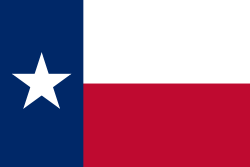Plano, Texas
| The Colony | Frisco | Allen |
| Carrollton | Plano | Parker |
|---|---|---|
| Dallas | Richardson | Murphy |
| City of Plano | |||
|
|||
| Nickname(s): An All-American City, P-Town, Gymnastic Capital of the World | |||
 |
|||
| Coordinates: | |||
| Country | United States | ||
|---|---|---|---|
| State | Texas | ||
| Counties | Collin, Denton | ||
| Government | |||
| - Mayor | Pat Evans | ||
| Area | |||
| - City | 71.6 sq mi (185.5 km²) | ||
| - Land | 71.6 sq mi (185.5 km²) | ||
| - Water | 0.1 sq mi (0.2 km²) | ||
| Elevation | 675 ft (206 m) | ||
| Population (2007) | |||
| - City | 260,796 (city proper) | ||
| - Density | 3,641.3/sq mi (1,405.9/km²) | ||
| - Metro | 6,145,037 | ||
| Time zone | CST (UTC-6) | ||
| - Summer (DST) | CDT (UTC-5) | ||
| ZIP codes | 75000-75099 | ||
| Area code(s) | 972, 469, 214 | ||
| FIPS code | 48-58016[1] | ||
| GNIS feature ID | 1344166[2] | ||
| Website: http://www.plano.gov | |||
Plano (IPA: /ˈpleɪnoʊ/) is a city in Collin and Denton Counties in the U.S. state of Texas. Located mainly within Collin County, it is a wealthy northern suburb of Dallas. The population was 222,030 at the 2000 census, making it the ninth largest city in Texas. According to a 2007 census estimate, Plano had grown to 260,796 making Plano the sixty-ninth most populous city in the United States. Plano is within the Dallas–Fort Worth–Arlington metropolitan area, colloquially referred to as the Metroplex. The city is home to many corporate headquarters, including Ericsson Inc, Rent-A-Center, Crossmark, Perot Systems, Electronic Data Systems, JCPenney, Frito-Lay, Cinemark Theatres, Dr Pepper and UGS
In 2005, Plano was designated the best place to live in the Western United States by CNN Money magazine. In 2006, Plano was selected as the 11th best place to live in the United States by CNN Money magazine.[3] In addition to its many industries and good-quality living, Plano has excellent schools that consistently score in the top few percent of the nation, and has been rated as the wealthiest city in the United States by CNN Money [2]with a poverty rate of under 6.4%, and a median income for a family was $106,335. In 2008, Forbes.com selected Plano along with University Park and Highland Park as the three "Top Suburbs To Live Well" of Dallas.[4] Plano was also declared "Most Affluent City" in 2008 by the United States Census Bureau.
Contents |
History

In the early 1840s, several settlers came to the area around Plano. Several nearby facilities including a sawmill, gristmill and a store brought more people to the area. Mail service was established and after rejecting several names for the budding town (including naming it in honor of then-President Millard Fillmore), the locals suggested the name Plano, from the Spanish word for "flat," a reference to the terrain of the area. The name was accepted by the Post Office and Plano was born.
In 1872, the completion of the Houston and Texas Railroad helped the city to grow, increasing the population to more than 500 by 1874. In 1873, the city officially incorporated.
In 1881, a fire raged through the central business district, destroying most of the buildings: 51 in all. However, the town was rebuilt and business again flourished through the 1880s. In 1895 the PISD (Plano Independent School District) was formed.
Unlike many of the other Dallas suburbs, which were closer to Dallas itself, the population of Plano initially grew slowly, reaching 1,304 in 1900 and increasing to 3,695 in 1960. By 1970, however, Plano began to feel some of the boom its neighbors experienced following World War II. A series of public works projects and a change in taxes that removed the farming community from the town helped to increase the overall population of Plano. In 1970, the population reached 17,872 and by 1980, the population had exploded to 72,000 people. Almost unbelievably the sewers, schools and street development kept easy pace with this massive increase largely due to Plano's flat topography, grid layout and effective planning.
During the 1980s, many large corporations moved their headquarters to Plano, including JC Penney and Frito-Lay, which helped to further grow the city as more people desired to move closer to where they worked. By 1990, the population had reached 128,713 and now dwarfed the county seat of McKinney. In 1994, the city was recognized as an All-America City.
By 2000, the population nearly doubled again to 222,030, making it one of the largest suburbs in the Dallas area. However, the area's suburban sprawl has pushed beyond Plano and the city's population is stabilizing. Plano is completely locked in by other municipalities and cannot expand in area, and there is little undeveloped land remaining within the city limits. By 2005, its population was estimated to be 250,096.
Geography
According to the United States Census Bureau, the city has a total area of 71.6 square miles (185.5 km²).
Transportation
Plano is one of 12 suburbs in the Dallas area that opts into the Dallas Area Rapid Transit (DART) public transportation system. During most of its membership in DART, Plano was lightly served by bus lines, but in recent years, the Red Line of the DART light rail project has opened stations in Downtown Plano and at Parker Road which provide access to commuters traveling to work elsewhere in the Dallas area.
Plano was the first of many cities in Collin County to adopt a master plan for their road system. The use of wide, multi-lane, divided highways for all major roads allows for higher speed limits on those thoroughfares, generally 40 or 45 mph but sometimes up to 55 mph (89 km/h) on the northern section of Preston Road, and due to this, concerns for pedestrian safety have arisen.
Plano is served directly by several major roadways and freeways. Central Plano is bordered to the East by U.S. Highway 75, the West by Dallas North Tollway, the South by President George Bush Turnpike, and the North by SH 121 (which is currently under construction to be made into a toll road). Preston Road or State Highway 289 is also a major thoroughfare that runs through the city.
Business
Plano is the corporate headquarters for some of the country's largest and most-recognized companies. Tree-lined Legacy Drive in the 75024 zip code, between Preston Road and the Dallas North Tollway, is full of corporate campuses. The following companies headquarter in Plano:
- Adams Golf
- Dr Pepper Snapple Group (formerly Cadbury Schweppes Americas Beverages.)
- Cinemark Theatres
- Crossmark
- DealTaker
- Electronic Data Systems
- Frito Lay
- Gearbox Software
- Highland Homes
- Metromedia Restaurant Group (Bennigan's, Steak & Ale)
- Microtune
- PetroTel Inc.
- PFSweb
- JCPenney
- MotionZoneHD
- Perot Systems
- Picture People
- Prodea Systems
- Rent-A-Center
- Rug Doctor
- Safety-Kleen
- Tattooking
- VíaVienté
- Weyandt & Associates
- Working Solutions
Plano also has a large number of semiconductor and telecommunications companies in its Research and Technology District (RT) due in part to its proximity to the Telecom Corridor. The list includes:
- Alcatel-Lucent
- Genband
- Raytheon
- Telect, Inc.
- Texas Instruments
- Flextronics
- Ericsson
- Infosys Technologies
- MetaSolv Software
Plano is also a frequent destination for business travelers; 80% of out-of-area visitors visit for this purpose. This is due to the city's close proximity to Dallas, and due to the many corporations headquartered in Plano. The city also has a large convention center. Plano is locally famous for its annual hot air balloon festival.
Recently, Plano has made a concerted effort to draw retail to the area in an effort to boost sales tax returns. In 2001, the high end The Shops at Willow Bend opened with such stores as Neiman Marcus, Saks Fifth Avenue and Lord and Taylor. Recently The Shops at Legacy opened, It has apartments and numerous shops and restaurants and is known as a sophisticated hotspot. Wal-Mart also considered the city's affluence when it decided to establish the experimental luxury Wal-Mart Supercenter on Park Road and the Dallas North Tollway.
Education
There are 70 public schools, 16 private schools, one college (Collin County College), and 6 libraries in Plano [3].
Plano Independent School District serves most of Plano. Due to a massive increase in student enrollment over the past few decades, Plano has a unique high school system, in which grades 9-10 attend a high school and grades 11-12 attend a senior high.
There are three senior high schools (grades 11-12) in PISD; Plano East, Plano Senior, and Plano West.
Small portions of Plano are served by the Lewisville Independent School District, Frisco Independent School District, and Allen Independent School District.
Plano is the home to two campuses of the Collin County College District, one at the Courtyard Center on Preston Park Boulevard and the larger Spring Creek Campus on Spring Creek Parkway at Jupiter.
In 2006, Plano Independent School District announced that 115 seniors were selected as National Merit Semifinalists, the largest in the district's history.
SMU in Legacy, of Southern Methodist University, is a graduate university serving the needs of 3,000 working professionals. Its academic programs include business, engineering and computer training, education and continuing education. It also features The Guildhall [4] that offers a Masters program in video game development.
Media attention over suicide and heroin use among Plano students
Plano students achieved notoriety following a cluster of nine suicides in 1983 that raised national awareness about suburban teenage depression. Most of the suicides were caused by carbon monoxide poisoning, however, a few of the suicides were caused by gunshot wounds. Plano students were again in the news in the late 1990s, the result of a city-wide heroin problem. The surge in heroin use culminated in coverage by several major news outlets such as NBC's Dateline and MTV's "Wasted." Heroin use in Plano eventually led to over a dozen overdose deaths of teenagers and young adults. Many more Plano heroin users suffered from overdoses that did not result in death. Based on the heroin epidemic among Plano youth, the Plano Police Department launched an undercover investigation known as "Operation Rockfest." The investigation led to 84 drug cases against 33 adults and four juveniles, including 14 students enrolled in Plano schools. [5]
In July 2003, Taylor Hooton, a student athlete at Plano West Senior High School, committed suicide which his family believed was connected to depression caused by the use of steroids used for performance enhancement. Much like the city's suicide and heroin issues of the 1980s and 1990s, this incident drew national focus to the issues of high school athletes and steroid use. Chris Wash was featured on the cover of the December 20, 2004, Newsweek magazine wearing a Plano West Senior High School shirt in an article about the use of steroids in high schools. On March 10, 2005, Don Hooton (the father of Taylor) testified before a Congressional Subcommittee about the use of steroids in high school. This was a widely covered event as several prominent baseball players including José Canseco and Mark McGwire testified as well.
Demographics
As of the census[1] of 2000, there were 222,030 people, 80,875 households, and 60,575 families residing in the city. The population density was 3,102.4 people per square mile (1,197.8/km²). There were 86,078 housing units at an average density of 1,202.8/sq mi (464.4/km²). The racial makeup of the city was 78.26% White, 5.02% Black, 0.36% Native American, 10.18% Asian, 0.04% Pacific Islander, 3.86% from other races, and 2.28% from two or more races. Hispanic or Latino of any race were 10.07% of the population.
Census figures from 2006 show a marked change in the racial composition of Plano, with increases in the percentages of Black (6.1%), Asian (14.7%), and Hispanic (14.4%) residents and a decrease in the percentage of White residents (75.6%).[5]
There were 80,875 households out of which 42.0% had children under the age of 18 living with them, 64.3% were married couples living together, 7.5% had a female householder with no husband present, and 25.1% were non-families. 20.2% of all households were made up of individuals and 2.9% had someone living alone who was 65 years of age or older. The average household size was 2.73 and the average family size was 3.18.
In the city the population was spread out with 28.7% under the age of 18, 7.0% from 18 to 24, 36.5% from 25 to 44, 22.9% from 45 to 64, and 4.9% who were 65 years of age or older. The median age was 34 years. For every 100 females there were 99.3 males. For every 100 females age 18 and over, there were 97.2 males.
According to a 2006 estimate, the median income for a household in the city was $77,038, and the median income for a family was $106,335.[6] Males had a median income of $64,668 versus $39,617 for females. The per capita income for the city was $36,514. About 3.0% of families and 4.3% of the population were below the poverty line, including 4.6% of those under age 18 and 7.8% of those age 65 or over. Average rents in Plano in 2005 were $662 for a one bedroom apartment, and $878 for a two bedroom apartment.
Plano was the highest income place with a population of 130,000 or more in 2000.
Plano was ranked the most affluent city in the United States with the lowest poverty rate of 6.3% for a city with a population exceeding 250,000. Its neighbor, Frisco, was ranked the richest city for the population of under 250,000 in the United States with a 2.7% poverty rate. Plano also has the highest median income in the nation at $71,000.[7]
Population growth
- 1874: 500
- 1890: 1,200
- 1900: 1,304
- 1910: 1,200
- 1960: 3,695
- 1970: 17,872
- 1980: 72,331
- 1990: 128,713
- 1994: 166,952
- 1995: 178,949
- 1996: 192,622
- 1997: 207,781
- 1998: 219,486
- 2000: 222,030
- 2003: 241,991
- 2004: 245,411
- 2005: 250,096
- 2006: 250,100[8]
- 2007: 286,600[9]
- 2008: 255,000[10]
Sister cities
Plano has five sister cities designated by Sister Cities International. This program's presence is seen in Plano ISD schools, where representatives from sister cities often meet and tour.
 Brampton, Ontario
Brampton, Ontario Ivanovo, Russia
Ivanovo, Russia San Pedro Garza Garcia, Mexico
San Pedro Garza Garcia, Mexico Port Adelaide Enfield, South Australia, Australia
Port Adelaide Enfield, South Australia, Australia Hsinchu, Taiwan
Hsinchu, Taiwan General Santos City, Philippines
General Santos City, Philippines
See also
- List of Plano Mayors
- Plano City Council
- Pat Evans (mayor)
- Jeran Akers
- Jack Harvard
- Florence Shapiro
References
- ↑ 1.0 1.1 "American FactFinder". United States Census Bureau. Retrieved on 2008-01-31.
- ↑ "US Board on Geographic Names". United States Geological Survey (2007-10-25). Retrieved on 2008-01-31.
- ↑ "Best Places to Live". Money (Cable News Network). 2006. http://money.cnn.com/magazines/moneymag/bplive/2006/top100/index.html.
- ↑ In Depth: Top Suburbs To Live Well - Forbes.com
- ↑ [1]
- ↑ http://factfinder.census.gov/servlet/ACSSAFFFacts?_event=Search&geo_id=16000US4827684&_geoContext=01000US%7C04000US48%7C16000US4827684&_street=&_county=plano&_cityTown=plano&_state=04000US48&_zip=&_lang=en&_sse=on&ActiveGeoDiv=geoSelect&_useEV=&pctxt=fph&pgsl=160&_submenuId=factsheet_1&ds_name=ACS_2006_SAFF&_ci_nbr=null&qr_name=null®=null%3Anull&_keyword=&_industry=
- ↑ http://www.nbc5i.com/money/9761212/detail.html NBC5i.com
- ↑ MONEY Magazine: 2006 City Snapshot
- ↑ MONEY Magazine: 2007 City Snapshot
- ↑ MONEY Magazine: 2008 City Snapshot
External links
- Official web site
- Plano's Online Community Resource
- Plano Economic Development Board
- Plano Convention and Visitors Bureau
- Information on Plano Real Estate
- Plano Taxi & Limo
- Plano from the Handbook of Texas Online
- Plano, Texas is at coordinates
|
|||||||||||||||||||||||
|
||||||||||||||||||||
 |
Dallas–Fort Worth–Arlington |
|---|---|
| Counties | Collin | Dallas | Delta | Denton | Ellis | Hunt | Johnson | Kaufman | Parker | Rockwall | Tarrant | Wise |
| over 1000 | Dallas† |
| over 500 | Fort Worth† |
| 200 - 500 | Arlington | Garland | Irving | Plano |
| 100 - 200 | Carrollton | Denton† | Frisco | Grand Prairie | McKinney† | Mesquite | Richardson |
| 50 - 100 | Allen | Euless | Flower Mound | Lewisville | Mansfield | North Richland Hills |
| 10 - 50 | Addison | Azle | Balch Springs | Bedford | Benbrook | Burleson | Cedar Hill | Cleburne† | Colleyville | Coppell | Corinth | DeSoto | Duncanville | Ennis | Farmers Branch | Forest Hill | Grapevine | Greenville† | Haltom City | Highland Village | Hurst | Keller | Lancaster | Little Elm | Rockwall† | Rowlett | Sachse | Saginaw | Seagoville | Southlake | Terrell | The Colony | University Park | Watauga | Waxahachie† | Weatherford† | White Settlement | Wylie |
| under 10 | Argyle | Blue Mound | Cockrell Hill | Combine | Cooper† | Crowley | Dalworthington Gardens | Decatur† | Edgecliff Village | Everman | Glenn Heights | Highland Park | Hutchins | Kaufman† | Kennedale | Lake Worth | Lakeside | Newark | Ovilla | Pantego | Pelican Bay | Richland Hills | River Oaks | Sansom Park | Sunnyvale | Westover Hills | Westworth Village | Willow Park | Wilmer |
| ↑ thousands of people† - County Seat. A full list of cities under 10,000 is available here. | |
|
|
|||||||||||
|
|||||||||||||

